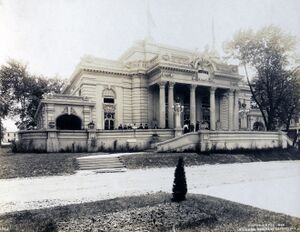Indiana
 Indiana State Building | |
| Construction Cost | $31,500 (equivalent to $950,017 in 2021) |
|---|---|
The building occupied a splendid position on the Plateau of States, facing the north and fronting on two of the main avenues. The dimensions of the Indiana building were 100 by 135 feet.
Etymology
Before the Fair
Description
Indiana's architecture was French Renaissance, and was surrounded by a broad terrace, with balustrade embellished with flowers and pedestals supporting vases with flowers and vines. The approach was through a spacious portico.
Inside, the building sported a post office, custodian's office, lunchroom, and display rooms. The vaulted ceiling contained a rather striking piece of stained glass, and was furnished with heavy leather upholstered furniture. On either side were men's and women's resting rooms in paneled oak, and were luxuriously furnished with rugs, upholstered furniture, and each was furnished with an upright piano.
On the second floor was a large library/reading room, in which were kept on file all the state newspapers and magazines, and all the principal daily papers and monthly magazines.
At one end of the building was the governor's reception room; at the other, the commissioners' reception room and private office. In connection with this latter was the art and literary department of the State, which contained copies of books by prominent Indiana authors and original manuscripts and drawings.
The electric lighting was a special feature of the building. A multitude of 4-candlepower lamps were used, distributed on the ceiling in pleasant form, that harmonized the decorative plaster panels.
The state made altogether seventeen exhibits in various exhibition palaces.
A featured display was an inlaid map of the United States.
The pavilion was dedicated June 3, 1904.
